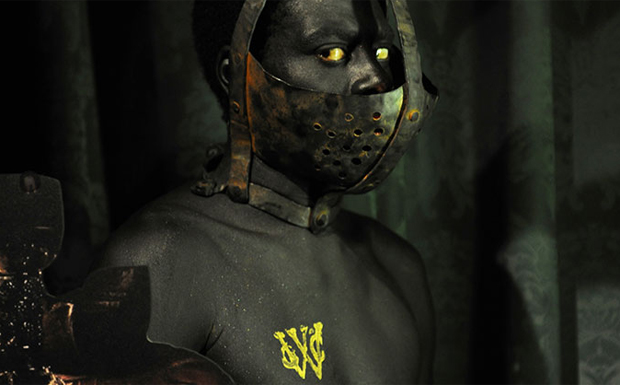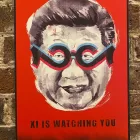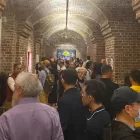24 Sep 2014 | News and features, Religion and Culture, United Kingdom

Exhibit B will take place at the Barbican Sept 23-27, 2014. (Photo: © Sofie Knijff / Barbican)
Update: Exhibit B was cancelled by the Barbican, the Evening Standard reported, after protesters blockaded the entrance and branded it ‘racist’.
If artistic culture is to be truly dynamic, strong, representative and relevant, the programmes in our theatres, galleries and museums will necessarily be challenging. The work, presented by many different voices, will likely be divisive; and causing offence, whether unintended or deliberate, is unavoidable.
The role of the arts institution in this dynamic cultural life is to manage the space between the artist and the audience, to create a place in which different ideas about the world we live in can be expressed, challenged, exalted, ridiculed and celebrated.
Brett Bailey’s Exhibit B, programmed for four days at the Barbican beginning tomorrow, has certainly caused considerable offence; 22,500 people have signed a petition calling for the Barbican to withdraw this exhibition, declaring their intention to protest outside the venue during the run.
The work by the South African theatre maker was inspired by human zoos, popular in 18th and 19th centuries, where human beings of African heritage were put in cages on display alongside animals for the titillation of European audiences. It recreates 12 tableaux of atrocities featuring live actors, who the audience is asked to observe in silence. Brett Bailey’s idea behind Exhibit B is to immerse the visitor in visions of horror and inhumanity to “provoke audiences to reflect on the historical roots of today’s prejudices and policies”.
What interests me here is the role and mindset of the institution presenting this piece of work and whether it considered, if at all, the possibility of a hostile response. I requested an interview with the Barbican, but was told they would speak after the show, once I had seen the exhibition.
For Exhibit B to be anything other than another here-today-gone-tomorrow exhibition that takes the messages of the work to heart, the Barbican would have to be engaged in dialogue with black artists and audiences as part of an ongoing commitment to eradicate institutional racism from the arts. Yet it is the boycott organised against this exhibition, with its petition, speeches, protests, marches, public meetings, pickets, on and offline debate that is ensuring that any dialogue is happening, albeit in reaction to the programming of Exhibit B, and from the outside.
In response to the boycott, Barbican commissioned Nitro to organise a public debate: Discussions, Learning and Legacy at Theatre Royal Stratford East Monday 22nd.
The panel for the passionate and heated debate about Exhibit B, excellently chaired by Olu Alake, featured six speakers – three supporting the boycott, including Sara Myers author of the Petition and three supporting the work including Louise Jeffries from the Barbican who programmed the work. After each speaker had had their say, the audience of around 150 people, unleashed a barrage of questions from the floor. The two hours allotted to the debate were woefully inadequate for the range and depth of opinion expressed. As anticipated the debate changed nothing in the short term, the work will open this evening as planned, but there was an urgent call for a longer, fuller discussion which hopefully Barbican will respond to as a matter of urgency.
By giving a major international platform to Exhibit B without significant contemporary context, engagement or dialogue, the Barbican is unwittingly shining a light on both its own failure and the failure of the wider arts and culture scene to challenge prejudice and policy in the arts in the United Kingdom. Surely it cannot be possible for the Barbican to stand by a work that purports to confront “colonial atrocities committed in Africa, European notions of racial supremacy and the plight of immigrants today” and not see that it is holding up a mirror to itself.
Mark Sealy, artistic director at Autograph Black Photographers, who I spoke to last week about the boycott, was unequivocal: “Since 1980s it is progress zero. Our institutions have failed to bring about change – whether it is academia, the McPhearson Report or funding policies – [black] people feel absented from power, authoring and having a voice” And the reason? “There are no consequences to this failure. These policies have not made an iota of difference. If they want their institutions to be truly diverse they would withdraw the money from institutions if they don’t deliver.”
Independent arts consultant Jenny Williams takes a pragmatic view by heading up the campaign JustCulture, featuring a 10-point manifesto for change, though she knows, also from years of experience, without investment and commitment from the establishment there is little hope that things will change. She has crunched the numbers: “The Arts Council funding of arts infrastructure is not fairly representing the 14% black and minority communities. 14% of ACE’s overall three-year investment of £2.4bn would equate to £336m – that’s £112m per year. The black and minority ethnic community contribute around £62m per year into the overall arts budget. Yet, the current yearly figure currently invested in black and minority ethnic-led work is £4.8m.”
In spite of this grossly unbalanced situation, the organisers of the boycott I have spoken to are talking about how they can turn this into a positive. As Sara Myers, author of the boycott told me, she sees the mass outpouring of frustration and outrage as a catalyst. “A door has opened and we want to take the opportunity to challenge stereotypes, rather than sit back and see them reinforced.” She was however shocked when she met the board and senior management of the Barbican – with one exception, all white.
In her five-star review of Exhibit B for The Guardian, Lyn Gardner says the show “reminds us that most history is hidden from view”. I would say history here is on display for all to see. I defend Brett Bailey’s right to present these horrendous atrocities from the past – anything else is censorship – and agree with Lemn Sissay that we should all be free to revisit this story “in every part of every generation”.
But the more potent issue here, is the perpetuation of institutionalised mono-cultural bias preventing the Barbican, and the vast majority of British arts institutions, from fostering and delivering a truly relevant cultural programme. This untenable form of censorship must be addressed and continue to be addressed long after Exhibit B has been and gone.
This article was posted on 22 September 2014 at indexoncensorship.org
12 Jul 2024 | Europe and Central Asia, Israel, Middle East and North Africa, News and features, Russia, United Kingdom
A Russian art collective which was due to open a show in London highlighting the plight of opponents of the Putin regime claim their exhibition was cancelled at the last minute because one of them was Israeli.
The Pomidor group was founded in Moscow in 2018 by the artists Polina Egorushkina and Maria Sarkisyants, but the duo was forced to relocate two years ago after the Kremlin crackdown on opposition activity. Egorushkina now lives in London and Sarkisyants in Ashkelon in southern Israel.
Their latest show, Even Elephants Hold Elections, was part of an ongoing project about free expression designed to challenge people in democratic countries to understand life in an authoritarian regime and reflect on their own experience. Pomidor’s work includes embroidered banners celebrating political prisoners which the artists display in friends’ windows and phone booths on the street.
Among these are tributes to Viktoria Petrova, imprisoned in a psychiatric unit for anti-war social media posts, Mikhail Simonov, a 63-year-old pensioner arrested for comments on other people’s social media and 13-year-old Masha Moskaleva, who was taken away from her father after drawing anti-war pictures at school.
The show was due to open on 3 July at the Metamorphika Gallery in east London. But on the evening before, the two artists were told the gallery had received messages raising concerns about “inappropriate behaviour” on social media.
This referred to two posts pinned on Maria’s Instagram account. One post from 7 October expressed her horror at the “terrible evil” and included the words, in Russian, “Israel my beloved, we are here, we are here to support each other, all my thoughts are with the kidnapped, let only them return home alive. Eternal memory to the fallen.” A second post marked the one-month anniversary and expressed solidarity with the Israeli hostages and their families.
Sarkisyants told Index they were called to an urgent meeting the next day: “They showed me the two posts and said you should clarify your position. I said, I am from Israel and there was nothing in the post but facts: 1200 people were killed and 300 became hostages.”
The gallery asked Pomidor to sign a joint statement with Metamorphika condemning “the Zionist regime”, which they refused to do. “I’m Israeli. I was there,” said Sarkisyants. “What they proposed was impossible for me to do”
After several hours of discussion, Pomidor suggested a compromise of putting the exhibition solely in the name of Polina, but the gallery demanded the collective remove all work connected with Maria. At this point the exhibition was cancelled.
Pomidor posted on Instagram: “The problem came up because Maria is from Israel.”
This is something the gallery strongly denies. Metamorphika founder Simon Ballester told Index: “We were really compassionate with her story. But we asked her to say she had empathy for Palestinians and was against the war crimes.”
Ballester said the problem came when Sarkisyants expressed her support for the Israeli government’s actions in Gaza.
“It’s outrageous” the artist told Index. “I told them I do not support Netanyahu or his government. I feel they betrayed us. We expected them to protect us, but they didn’t. But I support my country Israel and its people.”
Since the cancellation of the show, Metamorphika claims it has received over a thousand “hate mails, insults and threats”. According to Ballester, he and his colleagues have been accused of being “Nazis, rapists, antisemites and misogynistic scumbags”.
Asked if he now regretted cancelling the show he said: “I think it was the right thing. I’m sorry it was the day of the show. That was really unfortunate.” He said the gallery operated on humanist principles and was striving for peace and equality.
The Pomidor exhibition will next travel to Montreal in Canada and the artists are in discussion with a gallery in London to host the show later in the year.
30 Jun 2023 | China, News and features
A packed-out audience gathered at St John’s Church in Waterloo, London on Tuesday to see and hear an extraordinary night of talk, music and art aimed at showing how the Chinese Communist Party (CCP) reaches beyond its borders to repress freedom of expression around the world.
Badiucao, the political cartoonist, artist and human rights activist who is a target of the CCP, was the main speaker and detailed how the CCP attempts to suppress his work abroad and the lengths they will go to.
Known as the Chinese Banksy, Badiucao was born into an artistic family in 1986. He explained he was told by his father at a young age that to be an artist in China is dangerous, and he would have to leave the country to pursue his career. He left in 2009.

‘Tell China’s Story Well’, by Badiucao
“I didn’t want to be silenced and devalued by this terrible regime, and the way to go forward was to make art they don’t believe in,” he said.
However, in 2018 an exhibition of his work in Hong Kong was cancelled by organisers after threats made by the Chinese authorities. After this, he also felt there was a lack of interest to show his work in Australia but blamed a strategy of the CCP for this.
“The Chinese government are very good at playing mind games”, he said. “They will use a tactic of accusing people and countries of being racist, of simply being anti-Chinese.”
Fresh from his exhibition in Warsaw in June, Badiucao said the pressure from China not to exhibit his work in Europe has so far been successfully fought against, but the pressure has been ramped up. He explained that in Warsaw, when the exhibition was announced, the Chinese Embassy visited the museum and demanded its cancellation.

Banned By Beijing exhibition
“Wherever I take this exhibition, they follow me,” he said. “It’s a warning to anybody wanting to host my show, that you must handle the pressure you’ll get. However, what the CCP is doing is raising the bar for my future work.”
Baudicau feels that as a dissident abroad his work means the CCP will eventually catch up with him. He said: “To me it’s no longer a yes or no. It’s just a case of when. But the more people join [protest the CCP], we can all share this big burden together.”
Music was provided by the London Silk Road Collective, who performed the diverse music traditions found along the ancient Silk Road route, connecting Europe, Central Asia and South East Asia, with a particular focus on songs (both melancholy and hopeful) from the Uyghur region. Its singer, Uyghur campaigner Rahima Mahmut, spoke about the personal effects of being a dissident abroad when she explained the anguish of her sister recently dying in China but being unable to contact her family due to the CCP.
The event also marked the opening of the Banned by Beijing art exhibition, aimed at highlighting transnational repression from China. Badiucao’s artwork featured, as well as works from husband-and-wife painting duo Lumli Lumlong and cartoonist and former secondary school visual arts teacher Vawongsir. The exhibition will run in the crypt of St John’s Church, Waterloo until 10 July 2023.
14 Oct 2020 | News and features
[vc_row][vc_column][vc_single_image image=”115253″ img_size=”full” add_caption=”yes”][vc_column_text]“I was expecting some reaction,” artist and activist Paolo Cirio told Index on Censorship referring to his installation, Capture, which is made up of publicly-sourced photographs of police officers during protests in France. “But this reaction is much more than expected.”
The installation was due to open on 15 October at Le Fresnoy, a public institution for contemporary art in the north of France, but it was withdrawn following pressure from France’s Minister of Interior. In a tweet on 2 October, Minister Gérald Darmanin called Cirio’s work an “unbearable pillorying of women and men who risk their lives to protect us” and demanded that the exhibition be “deprogrammed” under threat of legal action.
Cirio did create a separate online platform to crowdsource the names of the police officers as part of his wider campaign against facial recognition, but the photographs in the installation at Le Fresnoy were to appear without names, dates, times or locations. He insists that the exhibition would have posed no risk to any of the police officers’ privacy.
“I have stated many times that I have done it even to protect their privacy and to show that [facial recognition] is a potential danger to them,” Cirio explained. “It’s dangerous for everyone even for the police.”
Cirio had hoped that Capture would highlight the asymmetry of power related to facial recognition by showing how the technology can be used “against” the same authorities that urge its use. “During protests police are always trying to cover their mask more and more, and cover their identification number or anything that can identify them, while they use facial recognition against the protesters,” Cirio explained.
“The reaction from the general public is also much more than I expected,” Cirio said. “It’s actually pretty tense – every day I get up and I receive very nasty or scary messages”. But he has also been receiving some messages of support. “Of course there are all the antifa or more left-wing people in France who consider me a hero in a way.”
Since his installation was removed from the programme, Cirio said that Le Fresnoy have offered to show just one of the videos from Capture, but none of the photos. “Basically they’re saying ‘we can still show your work but only this video’,” Cirio said. “They are trying to hide the entire part of the project about police by not showing it, by not even discussing it, which of course is not something I am going to accept.”
In a statement, Le Fresnoy’s director Alain Fleischer said that they had told Cirio that they “could never support a project [linked] to a digital platform where the public would be encouraged to identify and name policemen [sic]”. He said that the decision to remove Cirio’s exhibition was prompted not necessarily by the pressure from the interior minister but by the risk of legal prosecution arising from their association with his work.
“[T]hey were two different things,” Cirio said referring to Capture and the online platform crowdsourcing the names of police officers, accusing Le Fresnoy of linking them in order to justify their decision to censor the installation. “The truth is that they feel the pressure to show no photos of police officers at all.”
“Anyway, again I think it’s appropriate to say that the censorship is from the government, not from Le Fresnoy. I don’t have bad blood against them,” Cirio said. “I understand their position. Too bad they couldn’t stand up with me a little longer.”
Cirio is now discussing the case with three French lawyers, who agree that his installation does not violate French law. “They’re actually suggesting that I file a complaint against the interior minister for censorship,” he said.
“It’s very shocking that this is happening in France. Anyone would think that France is the cultural capital of the world and it’s where all the artists are and there’s total freedom of speech and instead it’s not really the case anymore I would say,” Cirio said.[/vc_column_text][/vc_column][/vc_row][vc_row][vc_column][/vc_column][/vc_row]



